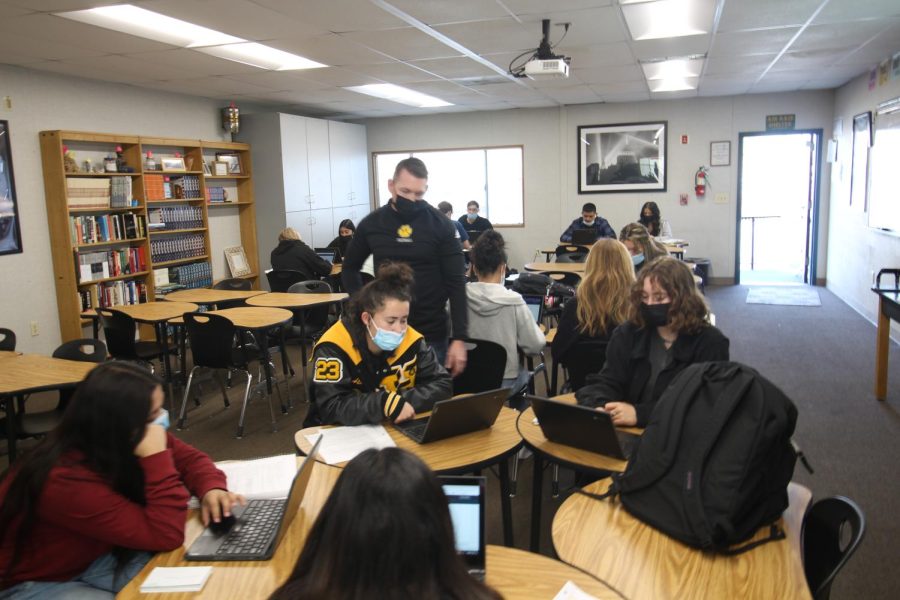AP and Honors: Then and Now
November 8, 2021
After 17 long months, the long-awaited time where students can go to school 5 days a week is finally here. Besides students, teachers are just as excited to be back to teaching in person, especially AP and Honors teachers.
It is no surprise that a lot has changed in the world due to the pandemic. One thing for example, is the pace that AP and Honors teachers were able to teach their students. Ms. McAndrews, an AP Government, AP US, and AP World History at HHS described her pace of teaching pre-pandemic as, “Organized, fast, rigorous.”
Jack Bland, an AP Art History teacher at HHS also described the pace of teaching pre-pandemic as, “Very Fast, We easily got through all of the required content with time to review for the AP test at the end of the school year.”
For over a year after the pandemic began, teachers had the responsibility of teaching students all-online. This was not only a struggle for students but also a struggle for teachers, especially for AP and Honors classes. Mr. Bland described the pace of teaching online as, “It was much slower and I focused only on the essential information students needed to prepare for the test at the end of the year. I had to pass over a lot of exercises that helped support context.”
Ms. McAndrews had a different experience teaching online than most teachers. She described teaching online as, “Pace didn’t change, expected that the rigor was the same, which was hard because I couldn’t guide them.”
Thankfully, after 508 days of not being able to go to school in-person for 5 days a week, we were finally able to come back August 10, 2021. Coming back to school in-person hasn’t been the easiest post-online. For most teachers, it’s been difficult to try and find a pace that isn’t too fast for the students and isn’t too slow that the students won’t learn everything they need to before finals. Adam Parker, a first year Math 2 Honors teacher at HHS said, “Post-online, the pace of my Honors class is going well. It is not quite as fast as I had envisioned, but I also want to account for any gaps in knowledge from the previous online year.”
Ms. McAndrews said that even after teaching post-online, she will still require her students to learn at the same pace that they did pre-pandemic. “It’ll be the same, except for more reading in a shorter period of time. Having them read over the summer helped build a foundation for the students.”
Cameron Kroll, a first year Honors US History teacher at HHS, said regarding teaching post-online, This is the first year I have taught this course so I can not compare. However, having students in person is so much better than online, especially for a course that requires so much discussion and debate. It is difficult to mimic that on zoom and in Breakout rooms.”
Mr. Bland agreed, saying, “I would prefer getting to where we were before the pandemic. I would say that a lot of the curriculum that was adjusted last year has helped in person classes as well. I have a lot more digital resources than I did pre-pandemic.”
For most students, learning post-online is a lot easier than learning online, especially because they are able to get the kind of interaction with a teacher that they wouldn’t be able to get online. It is the same way for teachers. Mr. Parker said that in his opinion, “Teaching post-online is definitely easier than online. Namely, because it is much easier to tell when my students are understanding the concept in person rather than online.”
Mr. Kroll said, “I definitely think that teaching in person is easier than online. I enjoy the interaction with students and you just don’t get that with blank boxes on Zoom. It is so much easier to help students when they are right in front of you.”
Although it has been a lot easier for teachers to teach in person rather than online, teaching post-online isn’t always easy. Mr. Parker said that some of the challenges with teaching post-online were, “The biggest challenges are addressing any gaps of knowledge that occurred during the online learning. The other big challenge is getting students to be less reliant on technology that aids solving math problems. Programs like Mathway, Photomath, etc. may seem like great tools, but students become so reliant on them during homework, that they don’t acquire the necessary tools to perform well on tests.”
Ms. McAndrews said, “I noticed that students are much more addicted to their phones. I’ve noticed that I’ve had to tell students to put their phone away much more. For some kids, working or being busy independently is hard.”
As a teacher teaching Honors for the first time, Mr. Parker wanted to include, “I am just honored to be teaching the students here at HHS and I believe this transition back to “normalcy” will always hit some speed bumps, but I know that we will persevere and come out the other side even better than before.”
Ms. McAndrew also wanted to say, “I’m so happy to be able to teach in person. The pandemic taught me that I need that thrive from teaching students and seeing their faces. That kind of interaction, I feel like I’m a better teacher.”
Mr. Bland also wanted to include, “I feel like our momentum is improving and I have positive feeling about the rest of this year. I am also very glad students are back in person.”


